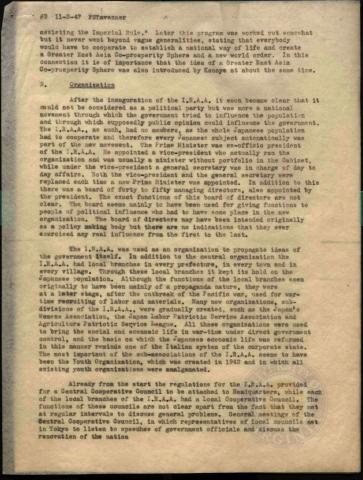
Page 2
| Parent | I.R.A.A. |
|---|---|
| Date | 11 March 1947 |
| Language | English |
| Collection | Tavenner Papers & IMTFE Official Records |
| Box | Box 4 |
| Folder | General Reports and Memoranda from March 1947 |
| Repository | University of Virginia Law Library |
# 2 11-3-47 FSTavenner
assisting ths Imperial Rule." Later this program was worked out somewhat but it never went beyond vague generalities, stating that everybody would have to cooperate to establish a national way of life and create a Greater East Asia Co-prosperity Sphere and a new world order. In this connection it is of importance that the idea of a Greater Cast Asia Co-prosperity Sphere was also introduced by Konoye at about the same time.
After the inauguration of the I.R.A.A. it soon became clear that it could not be considered as a political party but was more a national movement through which the government tried to influence the population and through which supposedly public opinion could influence the government. The I.R.A.A., as sucht had no members, as the whole Japanese population had to cooperate and therefore every Japanese subject automatically was part of the new movement. The Prime Minister was ex-officio president of the I.R.A.A. He appointed a vice-president who actually ran the organisation and was usually a minister without portfolio in the Cabinet, while under the vice-president a general secretary was in charge of day to day affairs. Both the vice-president and the general secretary were replaced each time a new Prime Minister was appointed. In addition to this there was a board of forty to fifty managing directors, also appointed by the president. The exact functions of this board of directors are not clear. The board seems mainly to have been used for giving functions to people of political influence who had to have some place in the new organisation. The board of directors may have been intended originally as a policy making body but there are no indications that they ever exercised any real influence from the first to the last.
The I.R.A#A. was used as an organisation to propagate ideas of the government itself. In addition to the central organisation the I.R.A.A. had local branches in every prefecture, in every town and in every village. Through these local branches it kept its hold on the Japanese population. Although the functions of the local branches seem originally to have been mainly of a propaganda nature, they were at a later stage, after the outbreak of the Pacific war, used for war-time recruiting of labor and materials. Many new organisation, sub¬divisions of the I.B.A.A., were gradually created, such as the Japan's Womens Association, the Japan Labor Patriotic Service Association and Agriculture Patriotic Servioe League. All these organisations were used to bring the social and economic life in war-time under direct government control, and the basis on which the Japanese economic life was reformed in this manner reminds one of the Italian system of the corporate state. The most important of the sub-associations of the I.R.A.A. seems to have been the Youth Organisation, which was created in 1943 and in which all existing youth organisations were amalgamated.
Already from the start the regulations for the I.R.A.A. provided for a Central Cooperative Council to be attached to Headquarters, while each of the local branches of the I.R.A.A. had a Local Cooperative Council. The functions of these councils are not clear apart from the fact that they met at regular intervals to discuss general problems. General meetings of the Central Cooperative Council, in which representatives of local councils met in Tokyo to listen to speeches of government officials and discuss the renovation of the nation
